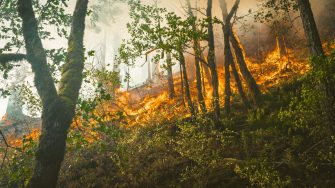
Synopsis
What happens to the ash that is deposited after a wildfire? Some of the ash is soluble, and this soluble fraction changes the chemistry of surface, soil and ground water.
Ash geochemistry is related to the elements and nutrients that were taken up by the vegetation as it grew, and also the intensity of the subsequent fire, which can also affect ash colour. When we measure the chemistry of water that contains soluble-ash products, we obtain information about the fire that has occurred.
Why is this important? Some soluble ash material dissolves after rainfall and enters water that infiltrates to the subsurface and into caves. There, the ash geochemical signal is incorporated into, and preserved in layers in cave stalagmites. We are analysing these stalagmites to obtain records of fire frequency and fire intensity in the past.
Remarkably, there have been very few geochemical studies of what happens when ash is dissolved in water. With a network of volunteers we have been collecting ash from wildfires, and we have new samples from the recent Margaret River region wildfire that would form an exciting honours project to explore the ash geochemistry of the 2021/2022 Western Australia wildfires.
Aims
We have samples of ash of different colours, which will enable the project to investigate the relationship between fire intensity and ash geochemistry.
We have samples of ash from different vegetation types, which will enable the project to investigate differences in bioaccumulation of metals and nutrients between species and sites.
Overall, the project will identify the geochemical indicators from wildfire ash that are best suited to identify past fires in cave stalagmites.
Student benefits
This project is aligned with and funded by an Australian Research Council Discovery Project led by Andy Baker and Pauline Treble (ANSTO). For more detail see https://www.ansto.gov.au/our-science/projects/reconstructing-australia’s-fire-history-from-cave-stalagmites . The project has been designed to be pandemic-proof with samples pre-collected and ready to analyse. The student will also be well guided and supported by supervisors. The honours researcher will experience research environments at both UNSW and ANSTO.
During this project, you’ll gain a range of skills, including:
- Experimental design and geochemical analyses using mass spectrometric and chromatographic techniques
- Data interpretation and statistical analysis with support to develop and improve coding and GIS skills
- Scientific writing skills
- Teamwork and project management skills as part of a cohesive research team
Eligible students are invited to apply for the AINSE Honours Scholarship: a $5,000 scheme that opens each December.
Supervisors: Andy Baker and Micheline Campbell (UNSW), Pauline Treble and Liza McDonough (ANSTO)
